Changeover
Originally Published
Originally Published NO June 2010
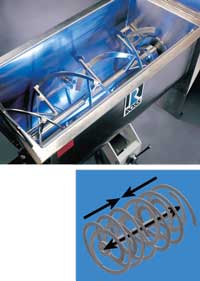
The beverage we know today as a fruit juice smoothie has come a long way since its humble start in the 1960s. In those days, smoothies were typically sold as a healthful snack alongside fresh carrot juice in neighborhood health food stores. Recipes varied, but with the limited selection of fruit and supplements available then, they were all more or less the same.
Forty-five years later, smoothies are sold worldwide in a multitude of retail locations-with sales of more than $3.4 billion in 6400 quick-service restaurants and fruit juice and smoothie bars in the United States alone.1 The retail market for smoothies is exploding with new outlets and product innovations. Smoothies are sold everywhere, from dedicated smoothie cafes and juice bars to restaurants, coffee shops, convenience stores, and the dairy cases of mainstream grocery stores. Smoothies are sweet desserts. They're grab-and-go dairy products. They're meal replacements, meal enhancements, and nutritious snacks. Moreover, the menu of available supplements has grown exponentially, and the nutritional profile available to consumers is stronger than ever.
The "gold rush" in the smoothie market really took off in the late 1990s as retail smoothie franchises exploded and major brands entered the competition via acquisitions and brand extensions. But despite the consolidation that accompanies this stage of maturation in any market, the fast-growing smoothie market still offers plenty of room for mom-and-pop restaurant operators and small franchises to cash in on the smoothie craze.
This frenzy of growth at retail provides a fruitful market for the wholesale smoothie suppliers that support frontline retailers. Especially in this economy, restaurant operators and franchises of all sizes are looking for outside sources for everything from basic ingredients to high-end supplements and product development. The opportunity is enormous, but the challenges are formidable. Fast growth in production must be managed carefully to avoid lapses in quality.
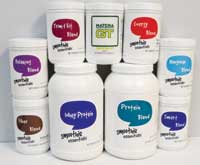
Wide-Angle Business Strategy
Boutique supplement marketer Total Nutrition Technology (TNT; Leesburg, FL) has been riding the smoothie wave since 2005. As the market grew, so did Total Nutrition Technology-averaging gains of more than 20% year after year. But unlike others that have suffered growing pains, this supplier has recorded unwavering growth that topped 36% in 2009, despite the recession.
According to TNT operations officer Lourdes McAgy, the secret to smooth growth is twofold. First, while so many other supplement providers became more specialized to gain efficiency, McAgy steered the opposite course to provide what she believes her clients really need in a tough economy.
"Especially now, working through a deep recession, our clients are all running hard and lean. They recognize the value of having a single, reliable partner standing by who can take on a wide variety of services whenever they're needed. So, we responded with a 'one-stop-shop' menu," she says. "We'll do anything and everything, from product development to private-label packaging, warehousing, and drop-shipping to individual franchise locations. To streamline ordering and fulfillment for our clients' franchisees, we'll also provide a custom online portal to take orders direct for private-label products."
She continues, "With versatility and speed in outsourced production, market leaders like Tropical Smoothie Café and Juice Bar Solutions can control their overhead, yet respond quickly to market trends with new products that extend and refresh their retail offerings." In a recent product-development push, for example, the company turned out 15 new smoothie-additive products in less than two months for Juice Bar Solutions.
"That kind of turnaround is what every franchise-large or small-needs in a tough economy, when competition is intense and you have to move fast to seize opportunities," says McAgy. "This particular product suite included a spectrum of supplements, from vitamins, minerals, and protein to fat-burning metabolizers, immunity-builders, and probiotics."
Close-Up Equipment Strategy
Complementing her wide-angle business strategy, McAgy believes in maintaining a close-up focus on the plant floor.
"In any processing environment, success depends on your ability to move fast, guarantee accuracy, and drive costs down. This is particularly true in a business like ours, where product recipes and production runs are constantly changing. So, we continuously monitor each step in production, watching to spot potential gains in four core parameters: cycle time, costs and pricing, end-product quality, and plant safety."
In a recent process assessment, the TNT management team recognized that substantial gains could be achieved in all four categories by upgrading the plant's blending equipment.
"Our process is blending-intensive," says McAgy. "We're running semi-continuously, with our blender discharging into bulk packaging or a filling machine that typically produces 50,000 single-serve packets each day. With our volume increasing steadily, we were bringing in two additional packaging lines [which have since been installed]. To feed them, we set out to improve our present blending process immediately and prepare for a big increase in blending capacity later this year."
Total Nutrition Technology had been using a V-Blender, a design that has been used in the food supplements industry for many years. (See illustration on page S-9.) The V-Blender has been a popular choice because it blends free-flowing solids gently and thoroughly. Turning at only 5 to 25 rpm, each batch is systematically split and recombined with each revolution, with highly predictable results.
"A V-Blender is great for many applications," says TNT executive officer Jay Kimelman. "But in our operation, it presented several limitations that were holding us back. So, that's where we started."
Meeting Equipment-Upgrade Goals
TNT had several specific requirements when it began searching for a V-Blender replacement:
- Faster blending, faster changeover, and greater production.
- More control over the process, especially discharge.
- More efficient use of plant space.
- Reduced risk of injury in the plant.
"We realized that our V-Blender was actually too gentle for us-unnecessarily gentle for most of our ingredients-and too slow. So, our number-one goal was to find a blender that could accelerate the process and shorten cycle times," says Kimelman.
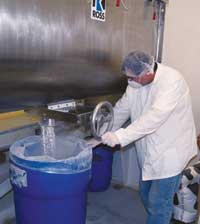
The equipment selection team consulted a number of blender manufacturers, including Charles Ross & Son Co. (Hauppauge, NY), a leading manufacturer of mixers and blenders.
"Smart equipment selection involves more than just process steps and a target blend," says Ross applications engineer Christine Banaszek. "Most application challenges can be solved with a variety of equipment choices and configurations. But every blender is both a process tool and a business tool. In this case, Total Nutrition Technology needed a blender that could meet its process goals and deliver a competitive advantage by reducing costs and increasing production to keep up with rising demand. Their V-Blender was capable of blending their ingredients, but it wasn't capable of supporting their business model."
The search quickly narrowed to a ribbon blender. This blender design operates with two sets of helical ribbons mounted on a shaft that turns in the center of a U-shaped trough. (See photo.) With the unit filled to between 40 and 100% of rated capacity, the ribbons typically operate at tip speeds of approximately 300 ft/min.
The ribbons are pitched and precisely positioned relative to one another to generate vigorous flow of material during the blending cycle. Together, the ribbons create radial flow in opposing directions. The outer ribbons move material toward the center of the blender; the inner ribbons move material outward from the center.
Because the ribbons move material at different speeds, in combination they also move material axially-along the unit's long axis, parallel with the shaft-and again in opposing directions. This complex combination of radial and axial mixing action promotes high-speed diffusion, convection, and shear.
"Compared to the V-Blender, which is a gentle, low-impact mixer, the ribbon blender is a high-energy device," says Banaszek. "The V-Blender rotates slowly and relies on the free-fall of batch materials to systematically split and recombine the batch. The ribbon blender applies great energy to develop vigorous agitation and drive materials into a homogeneous blend much more quickly."
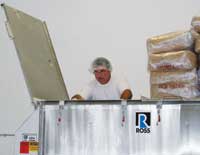
More-Efficient Changeover
"We saw an immediate acceleration of at least 76% in the blending process itself," says Kimelman. "But the improvement in discharge and changeover was even more beneficial for us."
V-Blenders rely on gravity for discharge-through a valve located at the bottom of the "V"-as well as blending. At Total Nutrition Technology, process operators who discharge blended materials into a variety of packaging and filling equipment needed more control over the discharge rate.
"Our ribbon blender is configured to give us a lot of flexibility," says Kimelman. "Electronic, variable speed control is normally considered important mainly for providing a 'soft start' when blending higher-density materials or for moderating the energy input to protect fragile ingredients. But in our plant, it's extremely valuable during discharge as well."
He continues, "We vary the ribbon speed to control the rate and accuracy of our discharge for a wide variety of ingredients. In the course of a typical day, we may discharge easy-to-handle, granular materials like malto-dextrin, fast-flowing powders like fructose crystals, and then reluctant materials like soy or whey that need encouragement to move quickly through the valve. With positive control over ribbon speed and a precise, gear-driven valve, we can move much faster and more accurately now than when we relied on gravity feed and a simple butterfly valve."
Thanks to the ribbon blender, Total Nutrition Technology has cut changeover time from 25 minutes to an average of 10 minutes between batches. Discharge accuracy has improved as well. But successful changeover also requires complete discharge and easy cleaning between batches to prevent contamination.
"That's absolutely critical in an operation like ours," says McAgy, "where many of our products have to be kosher- or halal-certified. We take this very seriously, which is why we've always passed surprise inspections with flying colors."
"Prevention is the best design strategy for fast and complete discharge, and the elimination of cross-contamination," says Banaszek. "The blender must hold close tolerances-in the range of 1/8 to 3/16 in.-between the ribbons and the trough to prevent 'dead zones' in the batch. The interior of the stainless-steel trough must be well-polished to prevent materials from hanging up on the vessel walls. And each joint must be radiused and polished to prevent a build-up that requires clean-up between cycles."
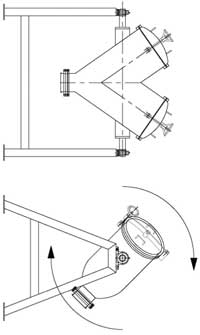
Use Every Square Foot Wisely-and Safely
The space required by a V-Blender represents significant overhead for any company. The blender rotates on a central axis, inverting the "V" with each revolution as it splits and recombines the batch material. At minimum, this large, moving piece of equipment requires a barrier surrounding it to prevent accidents. To further reduce the risk of injury, many companies devote a room exclusively to the blender.
For companies that do not really require a V-Blender, this over-allocation of space is a terrible drag on profitability. Especially in highly competitive environments like the smoothie market and the broader nutritional supplements market, a switch to a more space-efficient alternative can make a manufacturer significantly more competitive overnight.
"We knew that we needed to squeeze more value from every square foot of plant space," says McAgy. "But there's a much bigger issue here. By making the plant safer and more pleasant, we encouraged our employees to feel more confident and enjoy their work experience.
"We eliminated the hazard of a huge piece of equipment in motion. We cut down on ambient noise, since the direct-drive ribbon blender is so quiet. And we were able to squeeze more-productive equipment into the plant without having to expand-yet. It was a win-win-win."
Anticipating Future Needs
What does the future hold for Total Nutrition Technology?
"Flexible client service is our core business strategy," says McAgy. "To succeed, flexibility must be at the center of our production strategy, too."
"Flexible packaging and delivery, for example, will become even more important as we grow," she continues. "Many of our clients, from juice and smoothie bar franchisees to large food-service organizations, already require bulk packaging. So, we plan to add a high-capacity line later this year served by a 180-cu-ft ribbon blender. This will allow us to operate nimbly with our 50-cu-ft unit, serving shorter runs and discharging in private-label, single-serve packets, while the larger blender discharges into 25-lb containers."
Buying a Blender? Tips to Consider
BY CHRISTINE BAMASZEL, APPLICATION ENGINEER, CHARLES ROSS & SON CO.
When shopping for a blender, the specification process begins with posing a series of broad questions related to your manufacturing facility, your process, and your bottom line.
Questions to Ask
How much space is available?
If the plant offers limited floor space but plenty of open space overhead, a vertical cone screw blender may be a better choice than a horizontal ribbon blender or a tumble blender (like the V-Blender discussed in this article). The small footprint of a vertical cone screw blender may allow you to squeeze more capacity out of a crowded plant.
Gentle or more-aggressive blending?
If the product requires extremely gentle blending, either a cone screw blender or a tumble blender may be appropriate to avoid damaging delicate ingredients.
Batch consistency?
If you require the flexibility to blend very small batches occasionally, a cone screw blender or a tumble blender may be your best choice. A ribbon blender must be filled to between 40 and 100% of its rated capacity to blend efficiently.
Equipment budget?
Cost-efficiency is always important. But if your initial equipment cost is a critical concern, a ribbon blender will be your best bet. Note, though, that this advantage diminishes as the size of your batches increases, especially when you consider very large capacities.
The Workhorse Ribbon Blender
Thanks to the versatility and economy of the ribbon blender, this is the best choice for most mainstream blending applications. But as we narrow the specification process, there is still plenty of opportunity to optimize the blender for your needs today and in the future.
Every small gain in efficiency is important, because together all gains add up to a big difference in the bottom line. Design features like a removable ribbon, for example, can streamline cleaning, save time, and reduce the risk of contamination. Engineering the blender to handle ingredient densities upwards of 35 lb/cu ft, the standard rating for many traditional blenders, gives you greater versatility today and the promise of greater value tomorrow. An integrated motor/reducer with no belt or chain cuts down on noise, maintenance, and downtime.
Another valuable feature to specify for virtually all applications is electronic variable speed control. A simple variable frequency drive allows the operator to easily vary shaft speed, and it also enables constant torque operation over the entire speed range. Most important, electronic variable speed control provides "soft start" capability, which minimizes stress on the blender, even when blending a large batch of high-density material. This eliminates the need for a separate starter and "soft start" package.
Next step: Test!
Many more design decisions must be considered before you settle on the blender that will be right for your application. Especially for new products or processes that present challenges that you have not encountered before, consult with a manufacturer that is experienced in applications like yours and that offers a well-equipped laboratory where you can test your blender before you buy it. This will help ensure that the blender you choose will meet your needs today and well into the future.
As for the fruit smoothie market and the broader supplements market, McAgy and Kimelman see nothing but opportunity ahead.
"Consumer desire for better health and fitness will never stop growing," McAgy says. "In tough economic times, we may say no to some of the toys we'd buy in better times. But creating a healthier lifestyle will always be the number-one goal for Americans-and for us at Total Nutrition Technology."
References
1Juice Gallery: "The U.S. Juice and Smoothie Bar Market Report: 2008/09, 10th Edition"
The Nutritional Outlook Podcast Episode 39: Nutritional Outlook's Ingredients to Watch in 2025
February 25th 2025In this episode, Nutritional Outlook interviews Scott Dicker, market insights director from market researcher SPINS, about ingredients and product categories nutraceutical and nutrition product manufacturers should watch in 2025.










